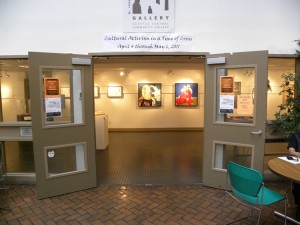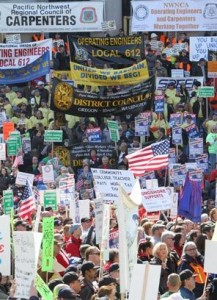Cultural Activism in a Time of Crisis, the exhibition
It is a time to return to blogging after the excitement of the book publication and the art exhibition. What better way than to analyze why the show “Cultural Activism in a Time of Crisis” is so exciting. As I have been giving people tours, I realized that all of these artists, whom I have been thinking about and writing about for several years for the book, are both deeply committed to social expressions and deeply committed to making strong art. Although I chose them to be in the book for that reason ( as well as the other 80 artists), seeing their work together in a fairly compact gallery space, where they speak loudly and clearly, each in a different medium and often on a different subject, underscores the power of their work. and the power of truly engaged artists to intervene in political discourses with new perspectives and new insights. In this time of perpetual visual imagery, visual artists are more important than ever to select and make more intense the subjects which we are all concerned about.
The installation, brilliantly resolved by Ken Matsudaira, the Director of the M. Rosetta Hunter Gallery at Seattle Central Community College, was very difficult because of the wide ranging aesthetics and topics, materials, and scale. We had glass, drawing, print making, paper, ceramic, painting, fabric, multi media installation and video. All of the work is on my website under www.artandpoliticsnow.com/exhibition. There are also installation shots on the website and a few pictures of the opening, and links to artists websites.
The topics addressed are maquiladora factories and their victimized workers, (Celia Munoz) the unremembered Chinese railroad workers ( Zhi Lin), Abu Ghraib (Daniel Heyman, Selma Waldman, Deborah Lawrence), La Malinche with a new feminist perspectives (Cecilia Alvarez), civilian casualities in war (Gail Tremblay), appealing to peacemakers to prevent war ( Ellen Sollod), Chinese immigration (Flo Wong), Argentinian disappearances (Claudia Bernardi), racism (Marita Dingus), the oppressions of the separation wall between Palestine and Israel, (Larissa Sansour), the oppressions of colonialism ( Maki Tamura) , the connection of past and present oppressions of native Americans in Alaska ( Tanis S’eiltin), the position of women in the midst of capitalist war(Deborah Lawrence), South African violence (Kim Berman), and the pertinence of ancient Indian spirituality to our contemporary world (Lillian Pitt).
It is a big range, and each one includes unusual conceptualizations, rare insights, and new perspectives. This is political art at its best. It completely refutes the tired dismissals of shallow thinkers who seem to think that art that engages issues is somehow second to art that is personal or is simply an assemblage of materials for their own sake. In fact those expressions are also political, in that the artists are choosing to deny that they live in a world with issues that are larger than they are, that affect them every day, that are part of who they are, even though they don’t know it. The artists in “Cultural Activism in a Time of Crisis” know these facts, they embrace not only who they are, but their place on the planet. That is the crucial act that all artists must follow today
At a recent “Conversation” sponsored by John Boylan, Seattle art critic, one participant, a young graduate student at the University of Washington, declared “there is no poetry in politics.” A young man who was attending and had just come from Wisconsin, said “Tell that to the people in Wisconsin.” In Wisconsin nobody is deluded into thinking that staring at their bellybutton is a way to stop the horrendous legislation that is being bullied through the state government. Being oblivious to the world means allowing the world to control you, more so every day. Exposure of wrongs and making visible those wrongs is what artists can do. The best ones are doing that.
When I went to Olympia to protest the budget cuts being perpetrated on the poorest, youngest, and sickest people of our state, at the expense of huge tax breaks for the wealthy, I saw some signs, some images, some log0s that were strong ( unfortunately I didn’t have a camera). The collective energy of 6000 union workers coming together was huge. But the most powerful moment for me was listening to the deep throbbing of a group of Indian drummers. The use of art heightened the event immeasurably and connected the past and the future.
Indians in the Northwest are more and more frequently appearing at political events or just outdoor events, drumming, and reminding us of our spiritual roots, and the importance of fighting for the survival of the planet every day in some way that we can.
This entry was posted on April 25, 2011 and is filed under Uncategorized.










